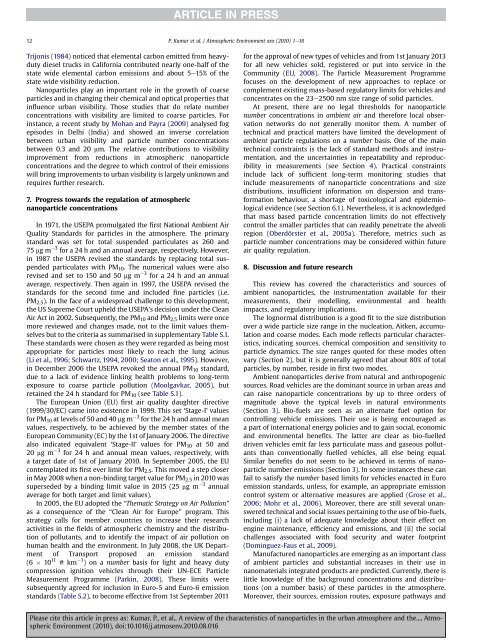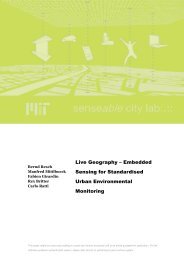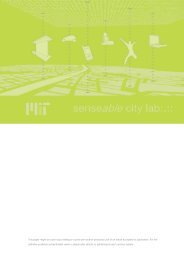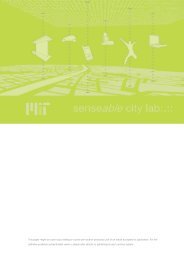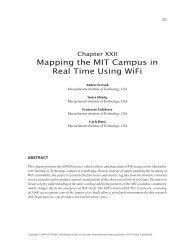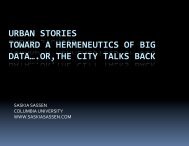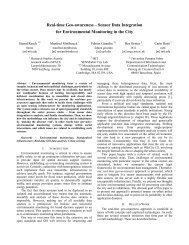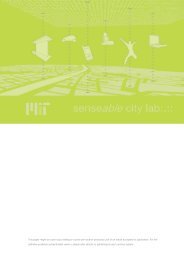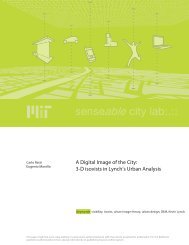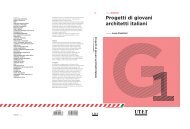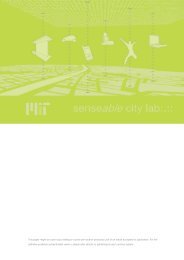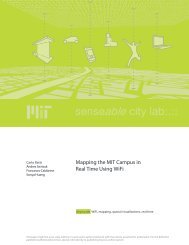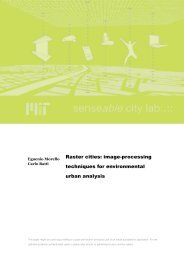A review of the characteristics of nanoparticles in the urban ...
A review of the characteristics of nanoparticles in the urban ...
A review of the characteristics of nanoparticles in the urban ...
You also want an ePaper? Increase the reach of your titles
YUMPU automatically turns print PDFs into web optimized ePapers that Google loves.
12<br />
P. Kumar et al. / Atmospheric Environment xxx (2010) 1e18<br />
Trijonis (1984) noticed that elemental carbon emitted from heavyduty<br />
diesel trucks <strong>in</strong> California contributed nearly one-half <strong>of</strong> <strong>the</strong><br />
state wide elemental carbon emissions and about 5e15% <strong>of</strong> <strong>the</strong><br />
state wide visibility reduction.<br />
Nanoparticles play an important role <strong>in</strong> <strong>the</strong> growth <strong>of</strong> coarse<br />
particles and <strong>in</strong> chang<strong>in</strong>g <strong>the</strong>ir chemical and optical properties that<br />
<strong>in</strong>fluence <strong>urban</strong> visibility. Those studies that do relate number<br />
concentrations with visibility are limited to coarse particles. For<br />
<strong>in</strong>stance, a recent study by Mohan and Payra (2009) analysed fog<br />
episodes <strong>in</strong> Delhi (India) and showed an <strong>in</strong>verse correlation<br />
between <strong>urban</strong> visibility and particle number concentrations<br />
between 0.3 and 20 mm. The relative contributions to visibility<br />
improvement from reductions <strong>in</strong> atmospheric nanoparticle<br />
concentrations and <strong>the</strong> degree to which control <strong>of</strong> <strong>the</strong>ir emissions<br />
will br<strong>in</strong>g improvements to <strong>urban</strong> visibility is largely unknown and<br />
requires fur<strong>the</strong>r research.<br />
7. Progress towards <strong>the</strong> regulation <strong>of</strong> atmospheric<br />
nanoparticle concentrations<br />
In 1971, <strong>the</strong> USEPA promulgated <strong>the</strong> first National Ambient Air<br />
Quality Standards for particles <strong>in</strong> <strong>the</strong> atmosphere. The primary<br />
standard was set for total suspended particulates as 260 and<br />
75 mg m 3 for a 24 h and an annual average, respectively. However,<br />
<strong>in</strong> 1987 <strong>the</strong> USEPA revised <strong>the</strong> standards by replac<strong>in</strong>g total suspended<br />
particulates with PM 10 . The numerical values were also<br />
revised and set to 150 and 50 mg m 3 for a 24 h and an annual<br />
average, respectively. Then aga<strong>in</strong> <strong>in</strong> 1997, <strong>the</strong> USEPA revised <strong>the</strong><br />
standards for <strong>the</strong> second time and <strong>in</strong>cluded f<strong>in</strong>e particles (i.e.<br />
PM 2.5 ). In <strong>the</strong> face <strong>of</strong> a widespread challenge to this development,<br />
<strong>the</strong> US Supreme Court upheld <strong>the</strong> USEPA’s decision under <strong>the</strong> Clean<br />
Air Act <strong>in</strong> 2002. Subsequently, <strong>the</strong> PM 10 and PM 2.5 limits were once<br />
more <strong>review</strong>ed and changes made, not to <strong>the</strong> limit values <strong>the</strong>mselves<br />
but to <strong>the</strong> criteria as summarised <strong>in</strong> supplementary Table S.1.<br />
These standards were chosen as <strong>the</strong>y were regarded as be<strong>in</strong>g most<br />
appropriate for particles most likely to reach <strong>the</strong> lung ac<strong>in</strong>us<br />
(Li et al., 1996; Schwartz, 1994, 2000; Seaton et al., 1995). However,<br />
<strong>in</strong> December 2006 <strong>the</strong> USEPA revoked <strong>the</strong> annual PM 10 standard,<br />
due to a lack <strong>of</strong> evidence l<strong>in</strong>k<strong>in</strong>g health problems to long-term<br />
exposure to coarse particle pollution (Moolgavkar, 2005), but<br />
reta<strong>in</strong>ed <strong>the</strong> 24 h standard for PM 10 (see Table S.1).<br />
The European Union (EU) first air quality daughter directive<br />
(1999/30/EC) came <strong>in</strong>to existence <strong>in</strong> 1999. This set ‘Stage-I’ values<br />
for PM 10 at levels <strong>of</strong> 50 and 40 mgm 3 for <strong>the</strong> 24 h and annual mean<br />
values, respectively, to be achieved by <strong>the</strong> member states <strong>of</strong> <strong>the</strong><br />
European Community (EC) by <strong>the</strong> 1st <strong>of</strong> January 2006. The directive<br />
also <strong>in</strong>dicated equivalent ‘Stage-II’ values for PM 10 at 50 and<br />
20 mg m 3 for 24 h and annual mean values, respectively, with<br />
a target date <strong>of</strong> 1st <strong>of</strong> January 2010. In September 2005, <strong>the</strong> EU<br />
contemplated its first ever limit for PM 2.5 . This moved a step closer<br />
<strong>in</strong> May 2008 when a non-b<strong>in</strong>d<strong>in</strong>g target value for PM 2.5 <strong>in</strong> 2010 was<br />
superseded by a b<strong>in</strong>d<strong>in</strong>g limit value <strong>in</strong> 2015 (25 mg m 3 annual<br />
average for both target and limit values).<br />
In 2005, <strong>the</strong> EU adopted <strong>the</strong> “Thematic Strategy on Air Pollution”<br />
as a consequence <strong>of</strong> <strong>the</strong> “Clean Air for Europe” program. This<br />
strategy calls for member countries to <strong>in</strong>crease <strong>the</strong>ir research<br />
activities <strong>in</strong> <strong>the</strong> fields <strong>of</strong> atmospheric chemistry and <strong>the</strong> distribution<br />
<strong>of</strong> pollutants, and to identify <strong>the</strong> impact <strong>of</strong> air pollution on<br />
human health and <strong>the</strong> environment. In July 2008, <strong>the</strong> UK Department<br />
<strong>of</strong> Transport proposed an emission standard<br />
(6 10 11 #km 1 )onanumber basis for light and heavy duty<br />
compression ignition vehicles through <strong>the</strong>ir UN-ECE Particle<br />
Measurement Programme (Park<strong>in</strong>, 2008). These limits were<br />
subsequently agreed for <strong>in</strong>clusion <strong>in</strong> Euro-5 and Euro-6 emission<br />
standards (Table S.2), to become effective from 1st September 2011<br />
for <strong>the</strong> approval <strong>of</strong> new types <strong>of</strong> vehicles and from 1st January 2013<br />
for all new vehicles sold, registered or put <strong>in</strong>to service <strong>in</strong> <strong>the</strong><br />
Community (EU, 2008). The Particle Measurement Programme<br />
focuses on <strong>the</strong> development <strong>of</strong> new approaches to replace or<br />
complement exist<strong>in</strong>g mass-based regulatory limits for vehicles and<br />
concentrates on <strong>the</strong> 23e2500 nm size range <strong>of</strong> solid particles.<br />
At present, <strong>the</strong>re are no legal thresholds for nanoparticle<br />
number concentrations <strong>in</strong> ambient air and <strong>the</strong>refore local observation<br />
networks do not generally monitor <strong>the</strong>m. A number <strong>of</strong><br />
technical and practical matters have limited <strong>the</strong> development <strong>of</strong><br />
ambient particle regulations on a number basis. One <strong>of</strong> <strong>the</strong> ma<strong>in</strong><br />
technical constra<strong>in</strong>ts is <strong>the</strong> lack <strong>of</strong> standard methods and <strong>in</strong>strumentation,<br />
and <strong>the</strong> uncerta<strong>in</strong>ties <strong>in</strong> repeatability and reproducibility<br />
<strong>in</strong> measurements (see Section 4). Practical constra<strong>in</strong>ts<br />
<strong>in</strong>clude lack <strong>of</strong> sufficient long-term monitor<strong>in</strong>g studies that<br />
<strong>in</strong>clude measurements <strong>of</strong> nanoparticle concentrations and size<br />
distributions, <strong>in</strong>sufficient <strong>in</strong>formation on dispersion and transformation<br />
behaviour, a shortage <strong>of</strong> toxicological and epidemiological<br />
evidence (see Section 6.1). Never<strong>the</strong>less, it is acknowledged<br />
that mass based particle concentration limits do not effectively<br />
control <strong>the</strong> smaller particles that can readily penetrate <strong>the</strong> alveoli<br />
region (Oberdörster et al., 2005a). Therefore, metrics such as<br />
particle number concentrations may be considered with<strong>in</strong> future<br />
air quality regulation.<br />
8. Discussion and future research<br />
This <strong>review</strong> has covered <strong>the</strong> <strong>characteristics</strong> and sources <strong>of</strong><br />
ambient <strong>nanoparticles</strong>, <strong>the</strong> <strong>in</strong>strumentation available for <strong>the</strong>ir<br />
measurements, <strong>the</strong>ir modell<strong>in</strong>g, environmental and health<br />
impacts, and regulatory implications.<br />
The lognormal distribution is a good fit to <strong>the</strong> size distribution<br />
over a wide particle size range <strong>in</strong> <strong>the</strong> nucleation, Aitken, accumulation<br />
and coarse modes. Each mode reflects particular <strong>characteristics</strong>,<br />
<strong>in</strong>dicat<strong>in</strong>g sources, chemical composition and sensitivity to<br />
particle dynamics. The size ranges quoted for <strong>the</strong>se modes <strong>of</strong>ten<br />
vary (Section 2), but it is generally agreed that about 80% <strong>of</strong> total<br />
particles, by number, reside <strong>in</strong> first two modes.<br />
Ambient <strong>nanoparticles</strong> derive from natural and anthropogenic<br />
sources. Road vehicles are <strong>the</strong> dom<strong>in</strong>ant source <strong>in</strong> <strong>urban</strong> areas and<br />
can raise nanoparticle concentrations by up to three orders <strong>of</strong><br />
magnitude above <strong>the</strong> typical levels <strong>in</strong> natural environments<br />
(Section 3). Bio-fuels are seen as an alternate fuel option for<br />
controll<strong>in</strong>g vehicle emissions. Their use is be<strong>in</strong>g encouraged as<br />
a part <strong>of</strong> <strong>in</strong>ternational energy policies and to ga<strong>in</strong> social, economic<br />
and environmental benefits. The latter are clear as bio-fuelled<br />
driven vehicles emit far less particulate mass and gaseous pollutants<br />
than conventionally fuelled vehicles, all else be<strong>in</strong>g equal.<br />
Similar benefits do not seem to be achieved <strong>in</strong> terms <strong>of</strong> nanoparticle<br />
number emissions (Section 3). In some <strong>in</strong>stances <strong>the</strong>se can<br />
fail to satisfy <strong>the</strong> number based limits for vehicles enacted <strong>in</strong> Euro<br />
emission standards, unless, for example, an appropriate emission<br />
control system or alternative measures are applied (Grose et al.,<br />
2006; Mohr et al., 2006). Moreover, <strong>the</strong>re are still several unanswered<br />
technical and social issues perta<strong>in</strong><strong>in</strong>g to <strong>the</strong> use <strong>of</strong> bio-fuels,<br />
<strong>in</strong>clud<strong>in</strong>g (i) a lack <strong>of</strong> adequate knowledge about <strong>the</strong>ir effect on<br />
eng<strong>in</strong>e ma<strong>in</strong>tenance, efficiency and emissions, and (ii) <strong>the</strong> social<br />
challenges associated with food security and water footpr<strong>in</strong>t<br />
(Dom<strong>in</strong>guez-Faus et al., 2009).<br />
Manufactured <strong>nanoparticles</strong> are emerg<strong>in</strong>g as an important class<br />
<strong>of</strong> ambient particles and substantial <strong>in</strong>creases <strong>in</strong> <strong>the</strong>ir use <strong>in</strong><br />
nanomaterials <strong>in</strong>tegrated products are predicted. Currently, <strong>the</strong>re is<br />
little knowledge <strong>of</strong> <strong>the</strong> background concentrations and distributions<br />
(on a number basis) <strong>of</strong> <strong>the</strong>se particles <strong>in</strong> <strong>the</strong> atmosphere.<br />
Moreover, <strong>the</strong>ir sources, emission routes, exposure pathways and<br />
Please cite this article <strong>in</strong> press as: Kumar, P., et al., A <strong>review</strong> <strong>of</strong> <strong>the</strong> <strong>characteristics</strong> <strong>of</strong> <strong>nanoparticles</strong> <strong>in</strong> <strong>the</strong> <strong>urban</strong> atmosphere and <strong>the</strong>..., Atmospheric<br />
Environment (2010), doi:10.1016/j.atmosenv.2010.08.016


